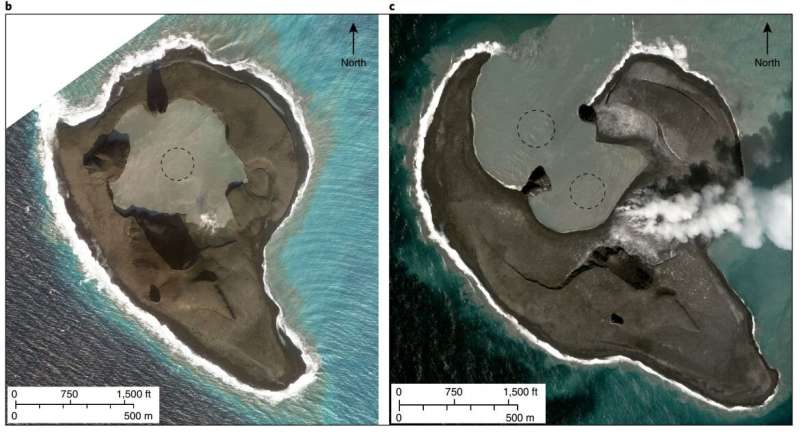October 21, 2019 report
Infrasound from underwater volcano erupting shows formation of gigantic bubbles

A team of researchers with the U.S. Geological Survey and the University of Alaska has found that they could estimate the size of bubbles that form from underwater volcanoes by listening to infrasound produced by bubble formation. In their paper published in the journal Nature Geoscience, the group describes their study of the infrasound that was produced by an undersea volcano eruption near an Aleutian island and what they learned from it.
The researchers note that studying undersea volcanoes is challenging due to their remoteness and the unpredictable nature of their eruptions. In this new effort, they report that perseverance and luck allowed them to learn something new about such eruptions—that the bubbles they create are far larger than anyone imagined.
Over the yeas, there have been accounts by sailors of the sea swelling just prior to the release of gas and particulate from volcanic eruptions below the surface. One such report came from a crewman aboard the Albatross during an expedition in the waters around the Aleutian Islands back in 1908. He reported that the ocean swelled into a dome that neared in size to the U.S. Capitol building. Then two years ago, an underwater volcano named Bogoslof erupted. It, too, is part of the Aleutian chain, and is in the process of building the island of Bogoslof. Fortunately, scientists had placed underwater microphones close enough to the volcano to pick up mysterious infrasounds produced during the eruption.
After studying the low-frequency infrasounds, the researchers found that they were produced by underwater bubble formation. They also found that the bubbles oscillated, indicating that they were changing in size. Further study of the infrasounds allowed the researchers to follow the progression of the bubbles as they made their way to the surface and to measure how big they were. When a single bubble reached the surface, it pushed the water above it into a dome. Then, as the bubble was exposed to the change in pressure, it expanded and contracted several times before finally collapsing. Once it collapsed, the gases and other material in the bubble escaped into the air and created a giant plume. The researchers further report that they measured bubbles as large as 440 meters across, far bigger than the U.S. Capitol dome.
More information: John J. Lyons et al. Infrasound from giant bubbles during explosive submarine eruptions, Nature Geoscience (2019). DOI: 10.1038/s41561-019-0461-0
Journal information: Nature Geoscience
© 2019 Science X Network


















